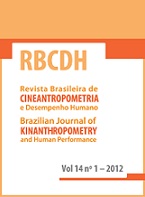Efeito de diferentes frequências semanais de treinamento sobre parâmetros de estresse oxidativo
DOI:
https://doi.org/10.1590/1980-0037.2012v14n1p52Resumo
Durante a contração muscular intensa induzida pelo exercício físico, há aumento na produção de espécies reativas de oxigênio, ocasionando estresse oxidativo em diversos órgãos, dentre eles o fígado e o coração. O treinamento físico pode aumentar as defesas antioxidantes e diminuir o estresse oxidativo. Contudo, ainda existem dúvidas sobre a frequência de treinamento necessária para melhorar parâmetros de estresse oxidativo. Este trabalho tem como objetivo verificar o efeito das frequências de duas e três vezes de exercício por semana sobre biomarcadores de estresse oxidativo no fígado e coração. Foram utilizados 18 camundongos machos (CF1), jovens (30 a 35g) divididos em grupos (n=6/grupo): não treinado (NT); treinado duas vezes por semana (T2) e treinado três vezes por semana (T3). Os animais foram submetidos ao treinamento durante oito semanas. Quarenta e oito horas após a última sessão os animais foram sacrificados. O fígado e o coração foram removidos e armazenados em freezer – 70ºC. Foram analisadas as substâncias reativas ao ácido tiobarbitúrico, carbonilação de proteínas, conteúdo total de tióis, atividades da superóxido dismutase , catalase e glutationa peroxidase. Os resultados demonstraram que apenas o grupo T3 reduziu dano oxidativo. Ademais, houve aumento no conteúdo total de tióis, atividades da superóxido dismutase e catalase no mesmo grupo em comparação com o não treinado. A atividade da glutationa peroxidase não apresentou diferença significativa entre os grupos. Este estudo demonstrou que somente a frequência de treinamento de três vezes por semana reduz dano oxidativo e aumenta a eficiência do sistema enzimático antioxidante de camundongos.
Downloads
Publicado
Edição
Seção
Licença

Direitos Autorais para artigos publicados nesta revista são do autor, com direitos de primeira publicação para a revista. Em virtude da aparecerem nesta revista de acesso público, os artigos são de uso gratuito, com atribuições próprias, em aplicações educacionais e não-comerciais, desde que seja dada a atribuição. Esta obra foi licenciada com uma Licença Creative Commons Atribuição 4.0 Internacional - CC BY


